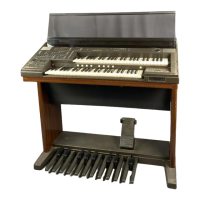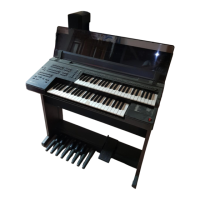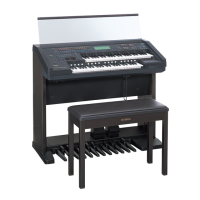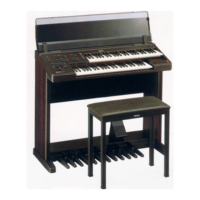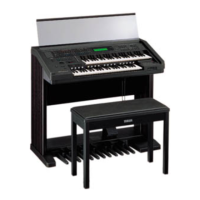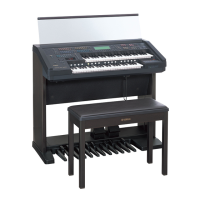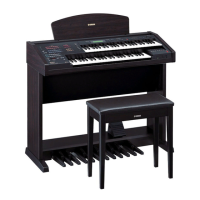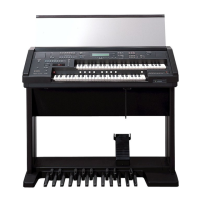Do you have a question about the Yamaha Electone EL-7 and is the answer not in the manual?
Explains safety graphics and caution symbols on the product enclosure.
Covers environmental awareness, battery notice, and product disposal guidelines.
Details U.S. FCC regulations, modifications, and interference guidelines for Class B digital devices.
Outlines Canadian regulations for radio noise emissions from digital apparatus.
Highlights AWM/FM tones, organ sounds, and flute voices for diverse sound creation.
Covers dynamic rhythms, automatic accompaniment, and registration menus for playing.
Mentions MIDI interface for instrument interaction and control.
Provides initial steps to power on, set volume, and use the expression pedal.
Introduces fundamental operations for playing the Electone.
Guides on selecting banks, numbered registrations, and organ sounds.
Explains how to initiate rhythm patterns using the START button.
Details how to turn off the Auto Bass Chord (A.B.C.) and Memory functions.
Guides on choosing voices from Upper, Lower, Lead, and Pedal sections.
Describes assigning Lead or Pedal voices to the Lower keyboard.
Explains adjusting volume levels for each voice section.
Details using dotted buttons to access extra voices and their functions.
Provides instructions for storing and selecting voices via dotted buttons.
Lists available extra voices, their locations, and model availability.
Guides on using flute footage and attack settings to create organ voices.
Explains how to adjust the volume level for created Flute Voices.
Describes pitch variation (Vibrato) and touch-sensitive timbre/volume (Touch Tone).
Explains how to use Sustain for sound decay and Tremolo for rotating speaker effect.
Guides on choosing rhythm patterns, variations, and starting playback.
Introduces the Auto Bass Chord function for automatic bass and chord backing.
Details using tempo buttons and display for rhythm speed control.
Explains the use of intro, ending, and lead-in patterns for rhythms.
Describes tempo buttons and the display for managing rhythm speed.
Explains how to incorporate Fill In patterns for rhythmic variety.
Guides on activating Accompaniment 1 and 2 for instrumental embellishments.
Explains Single Finger, Fingered Chord, and Custom A.B.C. modes.
Details Custom A.B.C. mode for controlling bass notes via Pedalboard.
Explains how Memory sustains accompaniment notes after key release.
Guides on turning on the Keyboard Percussion function using panel buttons.
Refers to charts detailing percussion sound assignments for keyboards and pedalboard.
Details percussion sound assignments for keys on the Lower keyboard.
Details percussion sound assignments for keys on the Pedalboard.
Explains adding harmony to melodies based on played chords.
Describes the SoloStyle feature for musical embellishments to the Lead voice.
Guides on saving custom settings and recalling stored registrations.
Explains how the D (Disable) button retains rhythm/accompaniment during changes.
Explains the Power On Reset function to delete stored registrations.
Covers controls for changing instrument key and fine-tuning pitch.
Details MIDI cable connections for synthesizers or rhythm machines.
Explains transmit and receive channel settings for MIDI communication.
Describes phone jacks for connecting an external rhythm machine.
Explains AUX OUT for amplification and HEADPHONES for private listening.
Addresses common problems like no sound, crackling, and interference.
Covers issues with polyphony, sustain, volume, and percussion sounds.
Addresses problems with accompaniment, pitch, and melody harmony.
Lists keyboard types, tone generation, voices, and effects details.
Details rhythms, accompaniment modes, and control functions.
Provides physical dimensions, weight, speakers, and optional accessories.
Details MIDI functions transmitted by the Electone.
Lists MIDI functions recognized by the Electone.
Covers MIDI channel messages and system realtime messages.
Explains bulk data transfer and model-specific MIDI messages.
Lists MIDI switch codes for various functions like voice selection and modes.
Details model-specific and common MIDI messages like Panel Switch Events.
Provides detailed MIDI codes for specific functions and settings.
Lists common MIDI messages for synchronous modes and requests.
Lists SoloStyle assignments mapping rhythm styles to lead and additional voices.
Covers basic safety precautions for electrical and electronic products.
Details safety regarding power, environment, and potential hearing damage.
Advises on qualified servicing, user maintenance, and product care.
Explains safety graphics and caution symbols on the product enclosure.
Covers environmental awareness, battery notice, and product disposal guidelines.
Details U.S. FCC regulations, modifications, and interference guidelines for Class B digital devices.
Outlines Canadian regulations for radio noise emissions from digital apparatus.
Highlights AWM/FM tones, organ sounds, and flute voices for diverse sound creation.
Covers dynamic rhythms, automatic accompaniment, and registration menus for playing.
Mentions MIDI interface for instrument interaction and control.
Provides initial steps to power on, set volume, and use the expression pedal.
Introduces fundamental operations for playing the Electone.
Guides on selecting banks, numbered registrations, and organ sounds.
Explains how to initiate rhythm patterns using the START button.
Details how to turn off the Auto Bass Chord (A.B.C.) and Memory functions.
Guides on choosing voices from Upper, Lower, Lead, and Pedal sections.
Describes assigning Lead or Pedal voices to the Lower keyboard.
Explains adjusting volume levels for each voice section.
Details using dotted buttons to access extra voices and their functions.
Provides instructions for storing and selecting voices via dotted buttons.
Lists available extra voices, their locations, and model availability.
Guides on using flute footage and attack settings to create organ voices.
Explains how to adjust the volume level for created Flute Voices.
Describes pitch variation (Vibrato) and touch-sensitive timbre/volume (Touch Tone).
Explains how to use Sustain for sound decay and Tremolo for rotating speaker effect.
Guides on choosing rhythm patterns, variations, and starting playback.
Introduces the Auto Bass Chord function for automatic bass and chord backing.
Details using tempo buttons and display for rhythm speed control.
Explains the use of intro, ending, and lead-in patterns for rhythms.
Describes tempo buttons and the display for managing rhythm speed.
Explains how to incorporate Fill In patterns for rhythmic variety.
Guides on activating Accompaniment 1 and 2 for instrumental embellishments.
Explains Single Finger, Fingered Chord, and Custom A.B.C. modes.
Details Custom A.B.C. mode for controlling bass notes via Pedalboard.
Explains how Memory sustains accompaniment notes after key release.
Guides on turning on the Keyboard Percussion function using panel buttons.
Refers to charts detailing percussion sound assignments for keyboards and pedalboard.
Details percussion sound assignments for keys on the Lower keyboard.
Details percussion sound assignments for keys on the Pedalboard.
Explains adding harmony to melodies based on played chords.
Describes the SoloStyle feature for musical embellishments to the Lead voice.
Guides on saving custom settings and recalling stored registrations.
Explains how the D (Disable) button retains rhythm/accompaniment during changes.
Explains the Power On Reset function to delete stored registrations.
Covers controls for changing instrument key and fine-tuning pitch.
Details MIDI cable connections for synthesizers or rhythm machines.
Explains transmit and receive channel settings for MIDI communication.
Describes phone jacks for connecting an external rhythm machine.
Explains AUX OUT for amplification and HEADPHONES for private listening.
Addresses common problems like no sound, crackling, and interference.
Covers issues with polyphony, sustain, volume, and percussion sounds.
Addresses problems with accompaniment, pitch, and melody harmony.
Lists keyboard types, tone generation, voices, and effects details.
Details rhythms, accompaniment modes, and control functions.
Provides physical dimensions, weight, speakers, and optional accessories.
Details MIDI functions transmitted by the Electone.
Lists MIDI functions recognized by the Electone.
Covers MIDI channel messages and system realtime messages.
Explains bulk data transfer and model-specific MIDI messages.
Lists MIDI switch codes for various functions like voice selection and modes.
Details model-specific and common MIDI messages like Panel Switch Events.
Provides detailed MIDI codes for specific functions and settings.
Lists common MIDI messages for synchronous modes and requests.
Lists SoloStyle assignments mapping rhythm styles to lead and additional voices.
Covers basic safety precautions for electrical and electronic products.
Details safety regarding power, environment, and potential hearing damage.
Advises on qualified servicing, user maintenance, and product care.
| Type | Electronic Organ |
|---|---|
| Power Supply | AC Power |
| Keyboard | 49 keys (Upper), 49 keys (Lower) |
| Rhythm Patterns | Multiple preset rhythm patterns |
| Effects | Reverb, Chorus |
| Speakers | Built-in speakers |
| Pedals | Sustain Pedal, Expression Pedal |
| MIDI | MIDI In/Out |

